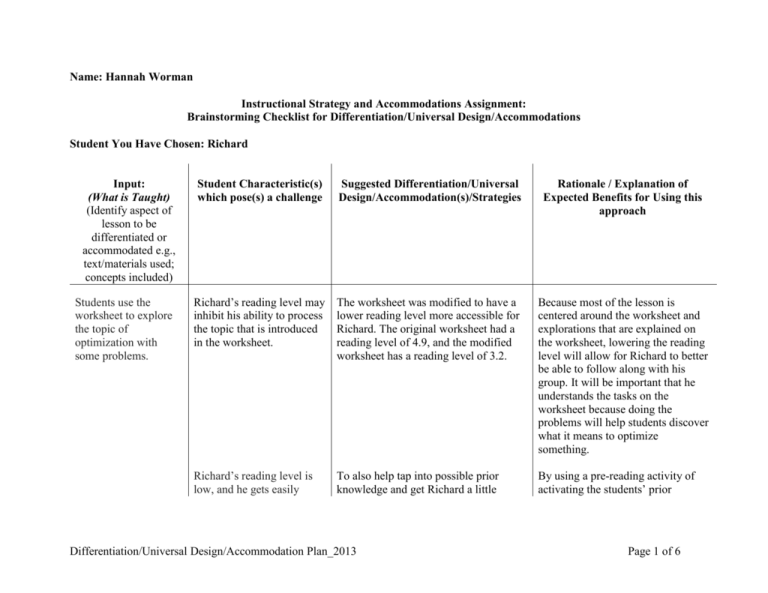Accommodations Brainstorming Sheet
advertisement

Name: Hannah Worman Instructional Strategy and Accommodations Assignment: Brainstorming Checklist for Differentiation/Universal Design/Accommodations Student You Have Chosen: Richard Input: (What is Taught) (Identify aspect of lesson to be differentiated or accommodated e.g., text/materials used; concepts included) Student Characteristic(s) which pose(s) a challenge Suggested Differentiation/Universal Design/Accommodation(s)/Strategies Rationale / Explanation of Expected Benefits for Using this approach Students use the worksheet to explore the topic of optimization with some problems. Richard’s reading level may inhibit his ability to process the topic that is introduced in the worksheet. The worksheet was modified to have a lower reading level more accessible for Richard. The original worksheet had a reading level of 4.9, and the modified worksheet has a reading level of 3.2. Because most of the lesson is centered around the worksheet and explorations that are explained on the worksheet, lowering the reading level will allow for Richard to better be able to follow along with his group. It will be important that he understands the tasks on the worksheet because doing the problems will help students discover what it means to optimize something. Richard’s reading level is low, and he gets easily To also help tap into possible prior knowledge and get Richard a little By using a pre-reading activity of activating the students’ prior Differentiation/Universal Design/Accommodation Plan_2013 Page 1 of 6 The teacher gives an introduction to the lesson. frustrated when he doesn’t understand what is asked of him. curious about the activities, the teacher’s introduction gives a clearer and more informative introduction to the worksheet. knowledge of getting the most for their money (optimizing their money), the students may feel that they can connect the topic of optimization to something that they have done before. Richard does best when teachers tap into his prior knowledge so this introduction discussion may help him. Also, talking about pets may interest more students and peak their curiosity as opposed to a lesson that does not have an activity that is grounded in real life. Output: (What the student does) (Identify aspect of lesson to be differentiated or accommodated e.g., assignments, tasks) Student Characteristic(s) which pose(s) a challenge Suggested Differentiation/Universal Design/Accommodation(s)/Strategies Rationale / Explanation of Expected Benefits for Using this approach Students are to complete a worksheet that requires them to optimize the area of multiple pens given an amount of fencing. Richard’s reading level might make understanding what is requested of him on the worksheet difficult. The worksheet was modified to have a lower reading level more appropriate for Richard. The original worksheet had a reading level of 4.9. After the modifications, the reading level is 3.2. Because Richard gets frustrated when he does not understand what is expected of him, changing the reading level of the directions throughout the worksheet will allow him to better be able to follow along. Differentiation/Universal Design/Accommodation Plan_2013 Page 2 of 6 Also, it will be required that someone in each group read each problem out loud before starting the problem. Since the worksheet requires multiple activities to do with his group, he might lose attention before he finishes all the activities. To allow for Richard to remain engaged and peak his curiosity, the teacher will supply the groups with popsicle sticks to signify the fencing. Because Richard’s verbal comprehension is at grade level, hearing the reading will also help him understand what is expected for each question. Having tangible items to work with and maneuver will allow Richard and other students to have something to work with if/when they get confused or frustrated with the task. It becomes more concrete when they have something to actually represent the fencing. This is aimed to help keep Richard’s attention level higher and his frustration level down. Students find the optimal dimensions and write their solution only on their worksheet. Richard might lose attention Each group will present one of the if he does not engaged. problems and must present a drawing Richard enjoys drawing. that includes dimensions for all of the fences. Creativity of the drawings will be encouraged. Because Richard enjoys drawing and excels at it, drawing the solution to present will hopefully help increase his engagement in the activity. He will be able to apply his drawing skills in math class. Students only graphed the parabola on their calculators. Richard enjoys drawing and his reading level is low. Having multiple representations of a concept is helpful for understanding. To help Richard, he enjoys drawing so having students draw the parabola will help keep him engaged/interested, and he will have a good drawing for his notes on the lesson. Students are required to draw the parabola that they graphed on their calculators. Differentiation/Universal Design/Accommodation Plan_2013 Page 3 of 6 Managing Behavior & Support (Includes scheduling/grouping changes) (Identify aspect of lesson to be differentiated or accommodated) Student Characteristic(s) which pose(s) a challenge Suggested Differentiation/Universal Design/Accommodation(s)/Strategies Rationale / Explanation of Expected Benefits for Using this approach Student groups were chosen by the students as they came into class. If other students move too quickly through the tasks and Richard does not understand right away, he may get frustrated and try to get out of doing the activity. In order to allow Richard the best learning environment, the student groups will be assigned before class by the teacher. Richard will not be assigned to a group with students who typically work very quickly or with students who may tend to be bullies. He will be assigned a group of classmates who are about the same level in the math class as him. The goal is to reduce Richard’s frustration level so that he keeps trying to work on the activity throughout the lesson. By not grouping Richard with students who typically work very quickly, it will reduce the likelihood that Richard will feel frustrated by not understanding what the demands of him are as a result of feeling that he is falling behind his group. This will hopefully prevent Richard from being verbally aggressive during class. Students are to complete a worksheet that requires them to optimize the area of Richard’s reading level might make understanding what is requested of him on the worksheet difficult. The worksheet was modified to have a lower reading level more appropriate for Richard. The original worksheet had a reading level of 4.9. After the modifications, the reading level is 3.2. By making the reading more accessible to Richard and having the groups read the problems out loud, this will help Richard understand the task demands. Because Richard gets Differentiation/Universal Design/Accommodation Plan_2013 Page 4 of 6 multiple pens given an amount of fencing. Students are directed to work with their groups to create an equation. Student Testing / Evaluation: (How you know what the student can do) Also, it will be required that someone in each group read each problem out loud before starting the problem. frustrated when he does not understand the task demands, these accommodations will hopefully help prevent Richard from becoming verbally aggressive during class. After the teacher asks the groups to create an equation for the area of the pens using variables, the teacher will go around to groups to make sure they understand the directions, starting with groups that may need more attention, like Richard. Having the teacher come around right away to make sure that the directions were clear will help keep Richard from getting frustrated if he has any confusion about what was asked. Student Characteristic(s) which pose(s) a challenge Suggested Differentiation/Universal Design/Accommodation(s)/Strategies Rationale / Explanation of Expected Benefits for Using this approach Richard may feel overwhelmed by the directions on the exit slip since it is meant to be done quickly at the end of class. Along with the directions/question being printed on the exit slip, the teacher will explain what is being asked out loud while passing out the exit slip. Richard is easily frustrated if he does not understand what is expected of him right away. (Identify aspect of lesson to be differentiated or accommodated e.g., assessment product) Students will fill out an exit slip at the end of class that asks them to write a quick summary of what it Differentiation/Universal Design/Accommodation Plan_2013 By having the directions given verbally, this will help Richard understand what is being asked on the exit slip better because his verbal comprehension is good. Page 5 of 6 means to optimize a quadratic equation and how they find the optimal point. Students do a worksheet as a group. Richard’s reading level is low, and he likes to draw. Also, the directions will be changed to allow students to include pictures to help them explain their point. Because Richard excels at drawing, he may feel more comfortable explaining his understanding of optimization by using pictures to supplement his explanations. The groups must draw one of their solutions and explain how they found the maximum area. Because Richard likes to draw, he will likely be more engaged in the group task of drawing their solution. Also, as the group presents their solution, the teacher can assess what they groups are understanding throughout their discovery of the meaning of optimization. Differentiation/Universal Design/Accommodation Plan_2013 Page 6 of 6






